Lesson 18
The Volume and Dimensions of a Cylinder
18.1: A Circle's Dimensions

Here is a circle. Points \(A\), \(B\), \(C\), and \(D\) are drawn, as well as Segments \(AD\) and \(BC\).
- What is the area of the circle, in square units? Select all that apply.
- \(4\pi\)
- \(\pi 8\)
- \(16\pi\)
- \(\pi 4^2\)
- approximately 25
- approximately 50
- If the area of a circle is \(49\pi\) square units, what is its radius? Explain your reasoning.
18.2: Circular Volumes
What is the volume of each figure, in cubic units? Even if you aren’t sure, make a reasonable guess.

- Figure A: A rectangular prism whose base has an area of 16 square units and whose height is 3 units.
- Figure B: A cylinder whose base has an area of 16\(\pi\) square units and whose height is 1 unit.
- Figure C: A cylinder whose base has an area of 16\(\pi\) square units and whose height is 3 units.
| prism | prism | prism | cylinder |
| base: square | base: hexagon | base: octagon | base: circle |
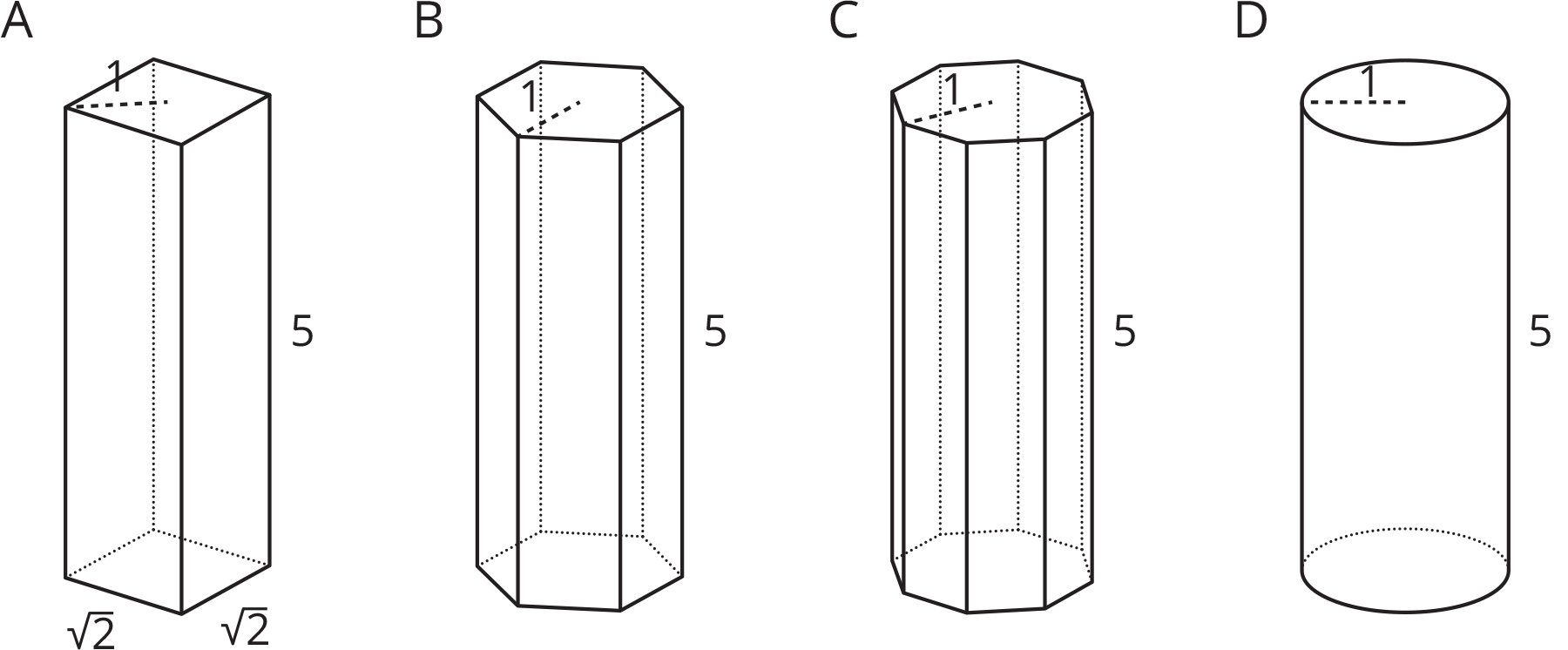
Here are solids that are related by a common measurement. In each of these solids, the distance from the center of the base to the furthest edge of the base is 1 unit, and the height of the solid is 5 units. Use 3.14 as an approximation for \(\pi\) to solve these problems.
- Find the area of the square base and the circular base.
- Use these areas to compute the volumes of the rectangular prism and the cylinder. How do they compare?
- Without doing any calculations, list the figures from smallest to largest by volume. Use the images and your knowledge of polygons to explain your reasoning.
- The area of the hexagon is approximately 2.6 square units, and the area of the octagon is approximately 2.83 square units. Use these areas to compute the volumes of the prisms with the hexagon and octagon bases. How does this match your explanation to the previous question?
18.3: What’s the Dimension?
The volume \(V\) of a cylinder with radius \(r\) is given by the formula \(V=\pi r^2h\).
-
The volume of this cylinder with radius 5 units is \(50\pi\) cubic units. This statement is true: \( 50\pi = 5^2 \pi h\)

What does the height of this cylinder have to be? Explain how you know.
-
The volume of this cylinder with height 4 units is \(36\pi\) cubic units. This statement is true: \(36\pi = r^2 \pi 4\)

What does the radius of this cylinder have to be? Explain how you know.
Suppose a cylinder has a volume of \(36\pi\) cubic inches, but it is not the same cylinder as the one you found earlier in this activity.
- What are some possibilities for the dimensions of the cylinder?
- How many different cylinders can you find that have a volume of \(36\pi\) cubic inches?
18.4: Cylinders with Unknown Dimensions
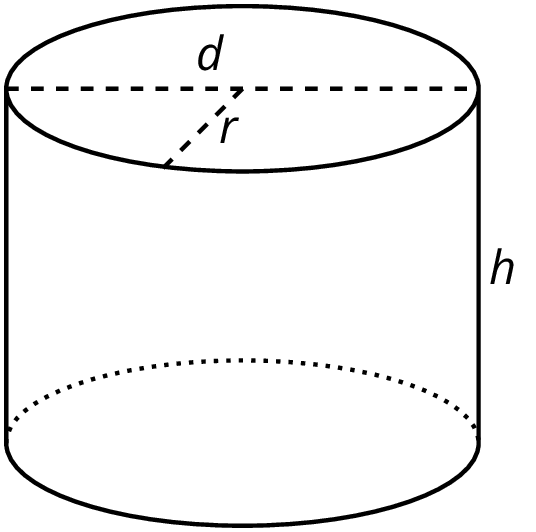
Each row of the table has information about a particular cylinder. Complete the table with the missing dimensions.
| diameter (units) | radius (units) | area of the base (square units) | height (units) | volume (cubic units) |
|---|---|---|---|---|
| 3 | 5 | |||
| 12 | \(108\pi\) | |||
| 11 | \(99\pi\) | |||
| 8 | \(16\pi\) | |||
| 100 | \(16\pi\) | |||
| 10 | \(20\pi\) | |||
| 20 | 314 | |||
| \(b\) | \(\pi \boldcdot b\boldcdot a^2\) |
Summary
We can find the volume of a cylinder with radius \(r\) and height \(h\) using two ideas we've seen before:
- The volume of a rectangular prism is a result of multiplying the area of its base by its height.
- The base of the cylinder is a circle with radius \(r\), so the base area is \(\pi r^2\).
Remember that \(\pi\) is the number we get when we divide the circumference of any circle by its diameter. The value of \(\pi\) is approximately 3.14.
Just like a rectangular prism, the volume of a cylinder is the area of the base times the height. For example, take a cylinder whose radius is 2 cm and whose height is 5 cm.

The base has an area of \(4\pi\) cm2 (since \(\pi\boldcdot 2^2=4\pi\)), so the volume is \(20\pi\) cm3 (since \(4\pi \boldcdot 5 = 20\pi\)). Using 3.14 as an approximation for \(\pi\), we can say that the volume of the cylinder is approximately 62.8 cm3.
In general, the base of a cylinder with radius \(r\) units has area \(\pi r^2\) square units. If the height is \(h\) units, then the volume \(V\) in cubic units is \(\displaystyle V=\pi r^2h\)
It is also true that if we know the volume and one dimension (either radius or height), we can find the other dimension.
For example, imagine a cylinder that has a volume of \(500\pi\) cm3 and a radius of 5 cm, but the height is unknown. From the volume formula we know that
\(\displaystyle 500\pi=\pi \boldcdot 25 \boldcdot h\)
must be true. Looking at the structure of the equation, we can see that \(500 = 25h\). That means that the height has to be 20 cm, since \(500\div 25 = 20\).
Now imagine another cylinder that also has a volume of \(500\pi\) cm3 with an unknown radius and a height of 5 cm. Then we know that
\(\displaystyle 500\pi=\pi\boldcdot r^2\boldcdot 5\)
must be true. Looking at the structure of this equation, we can see that \(r^2 = 100\). So the radius must be 10 cm.
Glossary Entries
- base (of a prism or pyramid)
The word base can also refer to a face of a polyhedron.
A prism has two identical bases that are parallel. A pyramid has one base.
A prism or pyramid is named for the shape of its base.
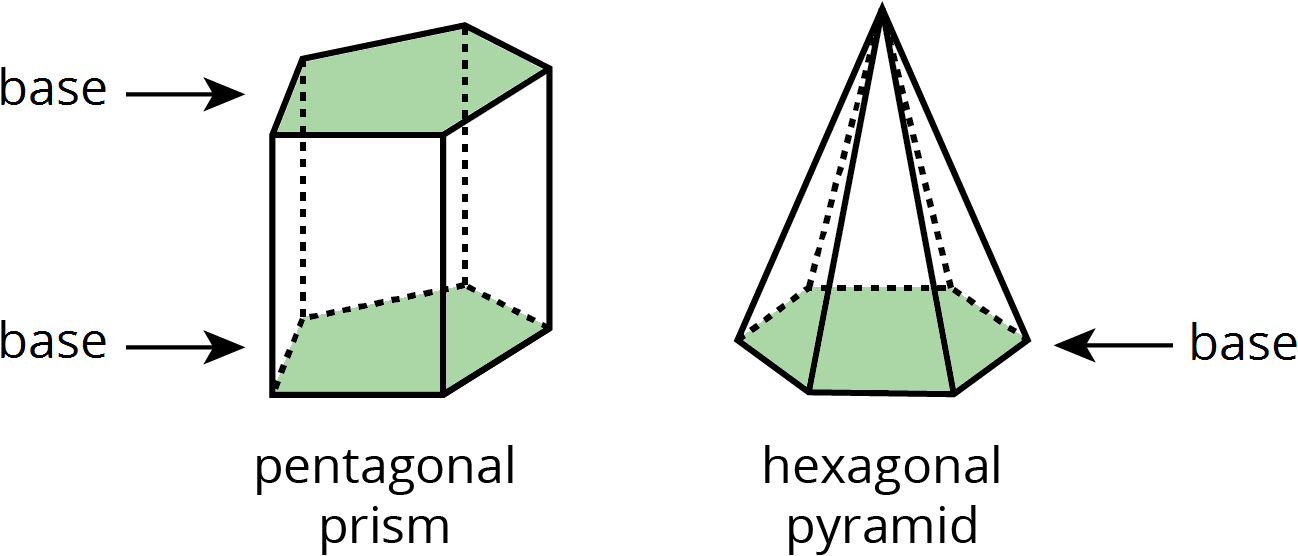
- cone
A cone is a three-dimensional figure like a pyramid, but the base is a circle.
- cross section
A cross section is the new face you see when you slice through a three-dimensional figure.
For example, if you slice a rectangular pyramid parallel to the base, you get a smaller rectangle as the cross section.
- cylinder
A cylinder is a three-dimensional figure like a prism, but with bases that are circles.
- prism
A prism is a type of polyhedron that has two bases that are identical copies of each other. The bases are connected by rectangles or parallelograms.
Here are some drawings of prisms.
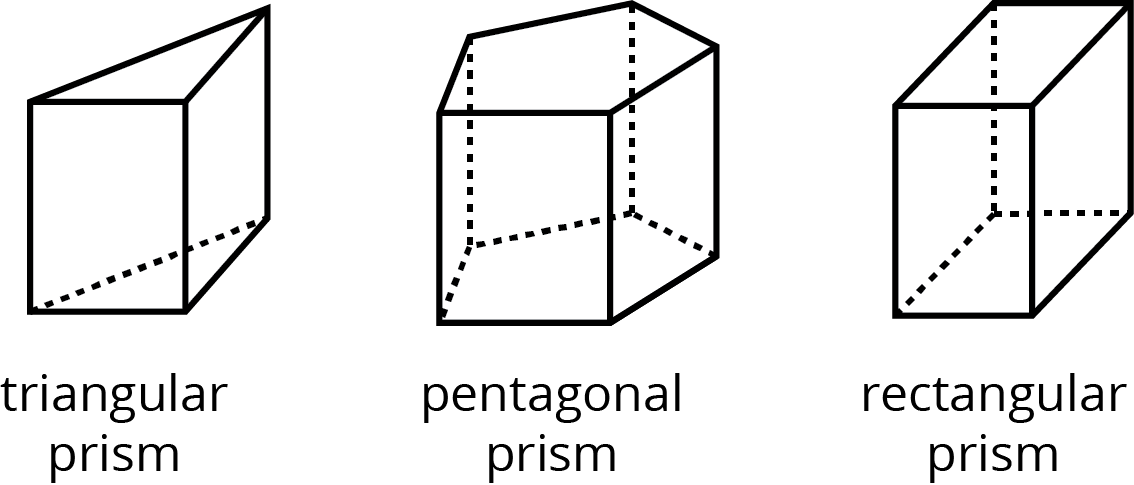
- pyramid
A pyramid is a type of polyhedron that has one base. All the other faces are triangles, and they all meet at a single vertex.
Here are some drawings of pyramids.
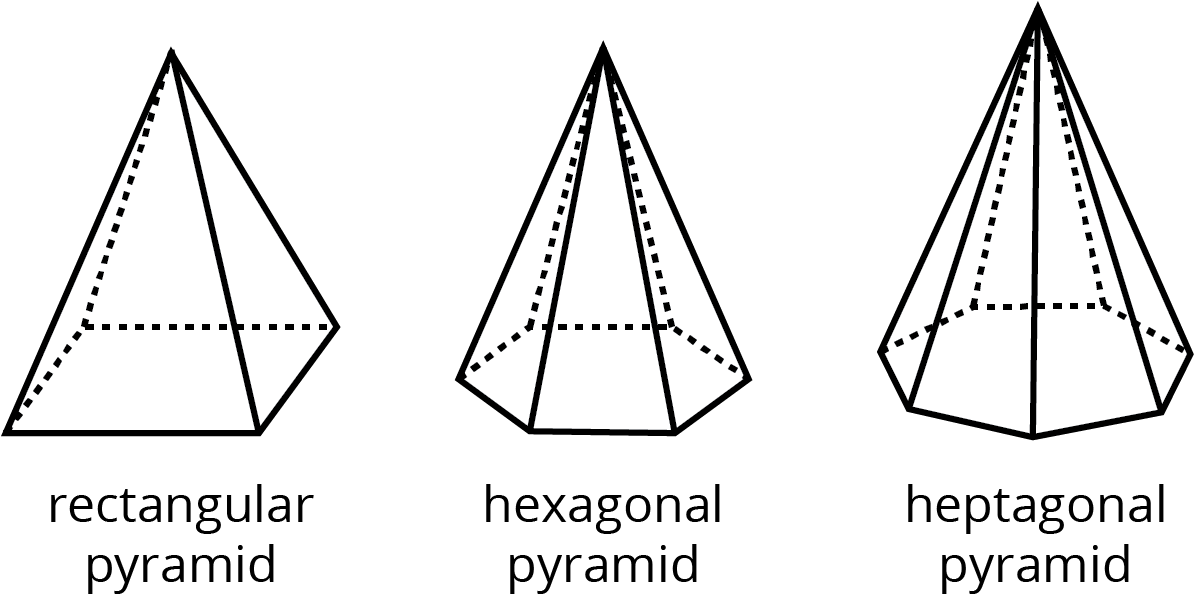
- sphere
A sphere is a three-dimensional figure in which all cross-sections in every direction are circles.
- surface area
The surface area of a polyhedron is the number of square units that covers all the faces of the polyhedron, without any gaps or overlaps.
For example, if the faces of a cube each have an area of 9 cm2, then the surface area of the cube is \(6 \boldcdot 9\), or 54 cm2.
- volume
Volume is the number of cubic units that fill a three-dimensional region, without any gaps or overlaps.
For example, the volume of this rectangular prism is 60 units3, because it is composed of 3 layers that are each 20 units3.
